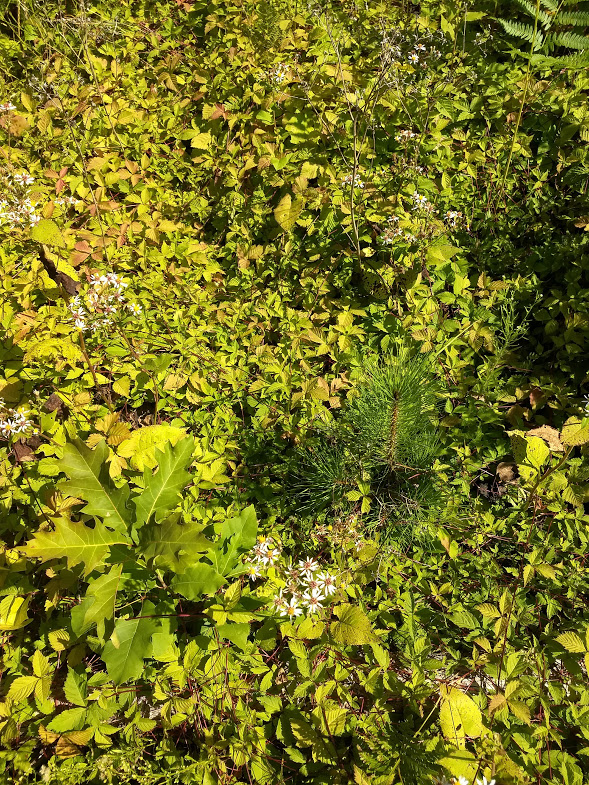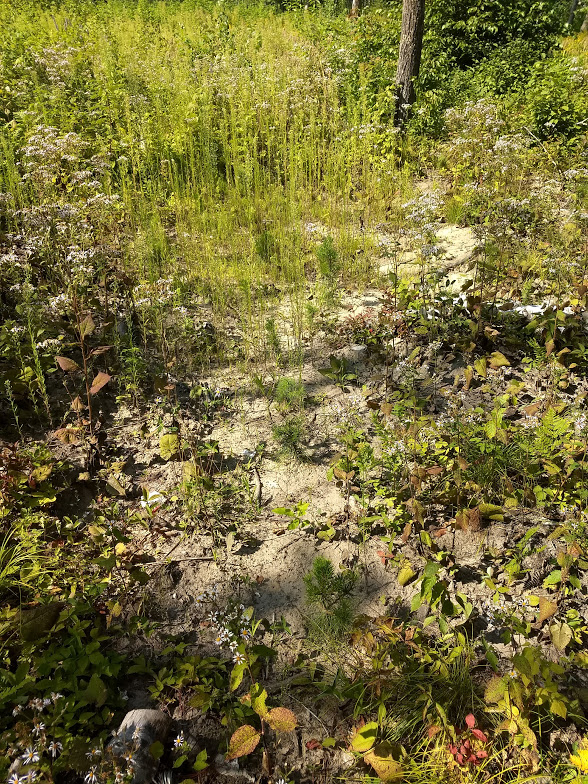Overview
The majority of the stand is comprised of over-mature jack pine, aspen, and birch that suffered a large amount of blow down damage in 2012. In order to maximize timber returns while still planning for the future, a timber sale was initiated to harvest the stand with the goal of increased diversity in the regeneration. A section (roughly 20 acres) of the timber sale was noted as “Heavy Blowdown” (Figure 1, cover image at the top of the page) and was therefore discounted. The stand was harvested in spring of 2016 and the wood was salvaged or left in piles to be burned. Planting took place one year later in the spring of 2017 after the area was site prepped by being harrowed through disc trenching. There was poor success with regeneration due to the soil being too thoroughly overturned during site prep. After giving the soil time to recover and reassessing the site a year later, conifers (jack pine, white pine, white spruce) were replanted in the spring of 2018. Natural regeneration of birch and aspen was allowed to occur through stump and root sprouting.

Figure 1: View from the landing showing the reserve trees and oak regeneration in the summer of 2018.

Figure 2: View from the landing showing the reserve trees and oak regeneration in the summer of 2018.
Silviculture Objective(s)
Create an even-aged system while promoting diversity and preparing the stand for the future. The amount of coarse woody debris will be limited to promote regeneration. Conifers will be protected from deer browse until they reach sufficient height. Habitat for wildlife will be facilitated and promoted.
Pre-treatment stand description and condition
Stand establishment and management history:
The stand was established in 1941 from natural origin. No regular management pattern was established for the stand but at the time of the blowdown event in 2012 the site was predominantly jack pine. At the time of harvest, the majority of the standing timber value came from the remaining aspen and birch.
Pre-treatment species composition:
Mature to over-mature aspen, paper birch, and jack pine.
Pre-treatment growth and stocking:
Aspen in this stand is large and over-mature with an average dbh of 14 to 16” and range from poor to good quality.
Jack pine in this sale range from 8 to 14” dbh, mature to over-mature, ranging from poor to good quality.
Blow down on site ranges from relatively intact to nearly 100% blowdown.
Pre-treatment forest health issues:
Blow-down, and limited regeneration of the understory of the stand due to high amounts of coarse woody debris present in the stand.
Landowner objectives/situation:
Bring the stand into a productive state by applying sound silvicultural and economic principles to the harvesting of timber, and by adequately providing for regeneration of the harvested areas.
Silviculture Prescription
Even-aged management via harvesting of all jack pine, aspen, birch within the stand. All other species not listed will be retained to increase diversity of species within the stand. The company harvesting the site will also salvage the coarse woody debris for firewood. Blowdown not suitable for firewood will piled on site and burned at a later date.

Figure 3: Jack pine amongst weeds that appear to be very healthy and doing well. Summer of 2018.
One year after harvesting the site will be prepped with a disk trencher that will be used to harrow the site with the primary goal of overturning the soil.
Immediately following site prep, conifers (jack pine, white pine, white spruce) will be planted with yearly site visits to analyze the regeneration of the site. Natural regeneration will occur through root sprouting from aspen, and stump sprouting from birch.

Figure 4: Many patches of raspberry and blackberry provide plenty of shade for the seedlings. Summer 2018.
Weeding and deer treatments will be implemented until the planted conifers are able to survive on their own. Deer browse will be mitigated by applying Plantskydd to seedlings. Brushing around seedlings will be performed approximately three times during seedling establishment time (6 to 8 years) to help them get above the brush line.
All non-dangerous snags will be retained.
The site is suitable for a summer harvest due to no wetlands and suitable soil types but work is to be completed by April 1st in order to reduce negative effects on the Northern Long-Eared Bat found in the area. Provisions for snag retention were also incorporated with this species in mind. Some slash was retained and made into small piles to facilitate den sites for wildlife. These piles numbered one for every two acres with an average size of 10-feet in diameter and 5-feet high. All other slash is to be removed for firewood or burned onsite at a later date.

Figure 5: A dwarf raspberry patch with oak and pine. Summer 2018.
A total of 47 plots taken within the stand using a 10 BAF prism for systematic sampling yielded volumes to be harvested that can be found in Table 1. Table 2 further breaks down the volumes to be harvested by tract.
Table 1: Appraised volumes.
| Species/Product | Estimated Volume | Stumpage Price | Value |
| Aspen - Pulp | 174.59 cords | $20.00/cord | $3,491.80 |
| Paper Birch - Pulp/Bolts | 232.26 cords | $13.00/cord | $3,019.38 |
| Jack Pine - Pulp/Bolts | 18.82 cords | $22.00/cord | $414.04 |
| Total Value | $6,925.22 |
Table 2: Volumes to be harvested by tract.
| Tract | Acreage | Species | Volume |
| 335A | 20.5 | Aspen | 81.31 cords |
| Paper birch | 129.84 cords | ||
| Jack pine | 4.68 cords | ||
| 335 | 20.9 | Aspen | 93.28 cords |
| Paper birch | 102.42 cords | ||
| Jack pine | 14.14 cords |

Figure 6: An aster patch in the summer of 2018.
What actually happened during the treatment
In the spring of 2016, the logging company harvested the stand and salvaged the downed wood for use of firewood.
In the spring of 2017, heavy equipment was brought in to prep the site for planting of conifers. A harrowing technique (discing) was utilized to turn over the soil. Seedlings that survived harvesting were treated with Plantskydd.

Figure 7: A red pine survivor from 2017 with an 18 inch leader.
In the spring of 2017, the site was planted with conifers. Assessments later revealed that the sandy Zimmerman soil was turned too thoroughly when being prepped for the planting. This lead to high levels of mortality due to heat scorching of the roots.
Between the spring of 2017 and spring of 2018 no management actions occurred at the site to give the soil time to recover and firm up. During this time natural regeneration of aspen and birch continued.

Figure 8: A very sandy site and the pines are taking nicely. Summer of 2018.
In the spring of 2018, the site was reassessed and deemed suitable for planting. The site was replanted with conifers without performing any further site prep work. A mixture of jack pine, red pine, and white pine were planted on the site. Small areas of abundant aspen regeneration were left in order to work towards creating a diverse mosaic for the future. Seedlings that survived the harvest were again treated with a Plantskydd application.

Figure 9: A surving pine next to a dead one. Summer of 2018.
Post-treatment assessment
Due to the recent timing and nature of the treatment there is currently not a lot of regeneration number for the stand but visual observations seem to show a higher success rate than the initial planting.
Plans for future treatments
Weeding and deer treatments will occur until the planted conifers are able to survive on their own. Deer browse will be mitigated by applying Plantsydd to seedlings until they are above browsing height. Brushing around seedlings will be performed several times in the next 6 to 8 years to allow the seedlings to be established above the brush line. These treatments will be halted when the trees reach a suitable height.
The stand will be cruised and analyzed in the future to decide when the stand should be thinned.
Other notes
There are two cultural sites located in/near the stands causing an area within the stand, and one outside the stand, to be buffered with orders to be avoided completely.
Summary / lessons learned / additional thoughts
This proved to be a more challenging site but overall the situation was handled well and proved to be effective. One thing to consider going forward is the overturning of the soil as it is important to consider drought conditions for the following years that could affect the stand. In the future, the stand will have increased diversity to better adjust for future climate conditions.

Figure 10: A small white pine seedling next to natural red oak regeneration. Summer of 2018.
